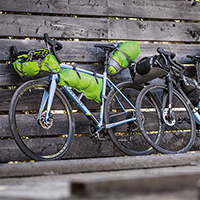The new trend –
taking the racing bike off road!
Racing fans have discovered the potential of gravel roads, forest paths and uneven roads. Until recently, these routes were mainly used by hardened mountain bikers. Now, a new generation of versatile racing machines designed to suit these conditions are gaining popularity. Thanks to their slightly wider tyres and sporty cycling style, they are sturdy enough for the gravel tracks yet fast enough for the road. These bikes are enormously versatile and will appeal to both racing fans and experienced mountain bikers.
Judging by the cycling world’s event calendar and what kind of bike the big brands are producing, the popularity of gravels biking is already on the rise. Most of the big manufacturers have at least one suitable model this season. For many different types of cyclist, gravel bikes are exactly the kind of model they are looking for. Over the following pages we’d like to introduce you to gravel biking and the character traits of the new bikes.
"For us, gravel represents the decompartmentalisation of cycling and a conscious decision to cycle however and wherever you want. What previously remained out of reach for many is now possible thanks to the growing popularity of gravel riding. We firmly believe that the gravel trend will lead to a new, endurance segment that will gain more and more enthusiastic supporters from both the road and the mountain biking camps."
Stephan Geiß, Brand Manager VOTEC
The modern gravel bike

What makes a gravel bike?
Gravel bikes, also referred to as all-road bikes, adventure bikes or disc-crossers, belong to the racing bike family despite their strengths off road. A close relative is the classic cyclocrosser, the gravel bike’s wheels differ in that they are wider. Long-distance or comfort racing bikes also had a great influence on the design of the gravel bike, as did the features of a mountain bike such as disc brakes, tubeless tyres or rugged drives. Without these influences, gravel bikes in their modern form would hardly be conceivable. Only the combination of the following features can result in a true gravel bike:
- A racing bike seat position for a sporty gait over asphalt stretches and unpaved tracks.
- A somewhat longer wheelbase compared to road racing bikes, usually disc brakes and often minimally profiled tyres between 32mm and 45mm in width.
- A comparison to the classic competition crosser, a less aggressive seat position and a lower bottom bracket for safety, efficiency and comfort over longer distances
The mixture of modern components and fine geometry differences actually creates a new genre. Manufacturers have interpreted their gravel bike models differently – some are sporty whilst others are more designed for every day use. Some models are designed more with the road in mind whilst others are more suited to rough terrain. This may initially confuse you, but the advantage is you’ll be able to find exactly the bike to suit your needs.
The variations
If you want a sporty racer designed for fast laps on changing surfaces, you should look for a low weight bike with a sporty seat position and a 1x11 drive system. These models usually have hydraulic disc brakes. A typical example of this kind of bike is the VOTEC VRX.
If you require a bike that is both comfortable and efficient even after hours of riding, a bike with more gears is necessary. Bikes with 2x11 gears and a comfortably sporty seating position designed for long distances are ideal. Depending on the kind of route you prefer, the bike should be able to accommodate relatively wide tyres.
If you want to use the gravel bike for road cycling, you need a model of gravel bike that allows mud guards to be attached. Several manufacturers are already fitting their models with mounting attachments as standard. Enough space for fenders in combination with 28mm or 30mm tyres is more often than not standard on all gravel bikes.
If you want your gravel bike to act as a sporty tourer for multi-day trips with luggage or as a fast commuter bike, you may want to have mudguards, luggage carriers and a light on the bike. Brakes on the frame and fork, a wide range of gears, simple technology and space for wide tyres are also important. Some manufacturers offer fully-equipped commuter gravel bike models as standard.
The origins
Like many cycling trends, the current gravel bike trend has its origins in the USA. There, at the beginning of the 2000s, a long-distance racing cycle scene developed. Born out of a desire to explore secluded side routes and varied terrain, gravel roads were more a necessity than a wish.
Longer passages on gravel roads were almost inevitable in the US hinterland, if one were to stick only to smaller roads. From road bike to dirt roads, the bicycles designed for road racing were regularly overburdened. Today, the US cycling scene is experiencing a real boom in long-distance gravel events, where thousands of cyclists tackle several hundred kilometers of tracks. What once was a niche sport is now hugely popular in the biking world.
Technical details of gravel bikes

The technical details of gravel bikes
In addition to riding behaviour, sitting position and thicker tyre allowance, there are several other important aspects of a gravel bike. Most importantly, the bike must be lightweight, stable and comfortable.
- The lighter the wheel, the quicker the bike moves
- Since they are designed for use off-road as well as on asphalt, gravel bike designs do not prioritise saving weight over other things.
- Unlike suspension mountain bikes, gravel bikes do not offer the same cushioning for the rider. Gravel bikes deliver a smooth feeling on asphalt and plenty of response on uneven terrain.
Frame & fork
As a rule, aluminum or carbon is used for the frame. Both materials make for very stable and light frames. Carbon frames are lighter and studier whilst aluminium is the preferred material for bikes as they are significantly cheaper. Almost all manufacturers use carbon forks because of the advantages with weight, stability and damping. For the same reasons, more expensive models also offer carbon handlebars and seat posts.
Disc brakes
The second key factor for gravel bikes is the disc brake. The significantly better braking capability justifies the effort for adjustments to the frame and fork and even the low weight of the disc stoppers. In the case of cheaper gravel models, mechanical or semi-mechanical disc brakes are often used, which already offer the high braking power independent of environmental conditions.
Wheels
Since rims aren’t needed for braking purposes, manufacturers have the possibility to build lighter rims made out of aluminum and carbon. Typically, gravel bike wheels also have a slightly wider rim to allow the tires to sit safely and solidly. The 12mm diameter of the standard axle instead of the traditional 5mm quick-release clamps provide additional stability in the chassis and wheels, without adding any real weight.
Tyres
The most striking characteristic of gravel bikes are the tyres, which are up to 45mm wide but don’t feature a typical rugged profile. The growing supply of wide yet fast rolling tyres is a key factor for the continuing success of gravel bikes. Tubeless tyres, which increase rolling properties and safety, are also widely used.
Drive
In order for the bike to suit a range of different riding environments, an extensive range of gears are necessary. Gravel bike models are therefore available with two different crank set combinations (50/34) or cross-ratios (46/36) which are combined with very wide-graded racing wheel cartridges. More and more, simple 1x11 drives are used which do not have a derailleur, just a left shift lever and only one chain ring. They are combined with extremely wide graded cassettes with up to 42 teeth which mean the bike is capable of tacking all gradients. The 1x11 drives also have the advantage of being simple and lightweight.
Tips for converting your bike into a gravel bike

Conversion tips: Make your own bike fit for gravel
Those who own an aero road bike or a suspension MTB are going to find it hard to convert their steed into a gravel bike. However, if you already have a road bike that can fit larger tyres or a cyclocrosser, you can considerably improve the long-distance capabilities and terrain potential with some small upgrades.
Wider, low-profile tyres
Road bikes often offer space for wider tyres. 30-40 mm and a lightweight tread pattern provide more volume, more comfort, better traction and higher safety reserves. A few millimeters difference to the classic street setup doesn't sound much, but it's clearly noticeable. For riders looking to have fun on and off-road, gravel tyres are the best choice. On cyclocross bikes we recommend changing cross tyres with lug tread for a lightly-rolling semi-slick.
More bandwidth for the drivetrain
Away from asphalt tracks lurk steeper climbs, pushing the pace and normal road bike ratios to their limits. In order to optimise the drivetrain, we recommend cassettes with a large bandwidth. That means as many sprockets (11-speed) and as many teeth as possible. The largest sprocket should have at least 32 teeth but the highter the better.
Tubeless instead of high pressure
Conversion kits offer everything you need to lose the inner tube from your tyre. Many tyres are now prepared for tubeless conversion and make changing easy. The advantage: more puncture resistance with less air pressure and rolling resistance. To go from tube to tubeless, you'll need a Tubeless-Kit with a suitable rim, a tubeless-ready tyre, sealing milk, a measuring cup, rim tape and a valve.
Comfort for hands & rear
Improve the comfort of riding gravel roads and the like by changing your bike's handlebar tape or replacing its racing saddle with a more suitable model.

































